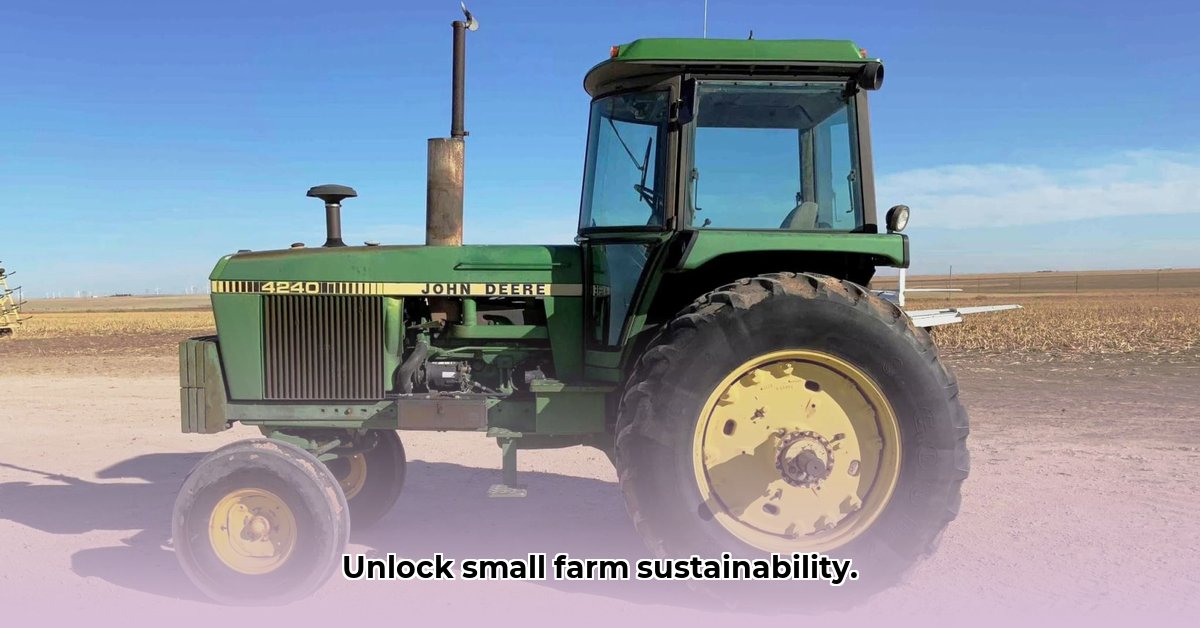
Evaluating the John Deere 4240 for Sustainable Small-Scale Farming
Considering a John Deere 4240 tractor for your small farm operation? This classic model, produced between 1978 and 1982, offers a unique blend of advantages and disadvantages in the context of modern, sustainable agriculture. This article provides a comprehensive analysis to help you make an informed decision. Is a relatively inexpensive JD 4240 the right fit for your operation, or should you look for a more modern alternative? Let's examine the facts. For those actively searching, check out available JD 4240s for sale.
Power and Efficiency: A Legacy of Performance
The JD 4240 delivers impressive power for its size, boasting up to 144.4 horsepower. However, its fuel efficiency is a key selling point for sustainable farming. Compared to newer, larger tractors, it often demonstrates significantly lower fuel consumption per hour of operation. This translates directly to reduced operating costs and a smaller carbon footprint. This makes the 4240 particularly attractive to small farms working with limited budgets and a strong commitment to environmentally sound practices. But fuel economy alone doesn’t paint the whole picture.
Durability and Longevity: A Timeless Workhorse
JD 4240 tractors are renowned for their robust construction. Many remain operational decades after their manufacture, highlighting their inherent durability. This longevity contributes significantly to long-term cost savings, minimizing the need for frequent replacements and reducing the environmental impact associated with tractor manufacturing and disposal. However, this durability also necessitates consistent maintenance to prolong its life; let's explore that.
Bridging the Technological Gap: Integrating Modern Practices
The JD 4240 lacks the sophisticated technology found in modern tractors. Features such as GPS guidance, automated steering, and variable-rate application systems are absent. This can limit the adoption of precision agriculture techniques, impacting overall efficiency and environmental stewardship. However, resourceful farmers are finding ways to integrate supplemental technologies to bridge this gap. This demands more hands-on involvement, but the potential for cost-effective improvements remains.
Maintenance and Repair: A Realistic Budgetary Consideration
Maintaining an older tractor like the JD 4240 requires a significant commitment to upkeep. Sourcing parts can be challenging, and repairs may be more complex and expensive than on newer models. Farmers should realistically factor these potential costs into their decision-making process. Learning basic tractor mechanics can be a cost-effective strategy. "Investing the time to learn basic repairs can save money in the long run," advises Dr. Emily Carter, Professor of Agricultural Engineering at Purdue University.
Is a JD 4240 Right for You? A Balanced Assessment
The suitability of a JD 4240 depends heavily on individual farm needs and priorities. Let's summarize the key advantages and disadvantages:
Advantages:
- Fuel Efficiency: Significantly lower fuel consumption compared to larger, newer models.
- Longevity: Durable construction results in a potentially long lifespan.
- Lower Initial Cost: Used JD 4240s are generally significantly cheaper than new tractors.
- Mechanical Simplicity: Simpler mechanical systems can make maintenance and troubleshooting more straightforward for mechanically inclined individuals.
Disadvantages:
- Lack of Modern Technology: Absence of precision agriculture features.
- Maintenance Challenges: Part sourcing and repair can be time-consuming and costly.
- Safety Features: Reduced safety features compared to modern tractors.
Actionable Steps for Different Stakeholders
The following table outlines practical steps for various stakeholders:
| Stakeholder | Short-Term Actions | Long-Term Actions |
|---|---|---|
| Small-scale Farmers | Research local sources for parts and repair services. | Invest in maintenance training, establish relationships with local mechanics, explore integration of supplemental technologies. |
| Equipment Dealers | Assess demand for JD 4240 parts and service; provide training. | Develop specialized JD 4240 repair and maintenance programs. |
| Agricultural Researchers | Compare long-term costs and environmental impacts of 4240s. | Investigate adaptation of precision agriculture technologies to older models. |
| Policymakers | Support policies ensuring access to affordable parts and training. | Create programs incentivizing maintenance training and skill development for older tractor mechanics. |
Retrofitting a John Deere 4240 for Precision Agriculture: A Practical Guide
Retrofitting a JD 4240 for precision agriculture is a viable option for increasing efficiency, but requires careful consideration. This section outlines a step-by-step approach.
Assessing Your Needs and Budget
Before beginning any upgrades, conduct a thorough needs assessment. What are your farm's biggest challenges? Where can precision agriculture tools offer the best improvements? This helps prioritize upgrades and allocate your budget effectively.
Choosing Precision Agriculture Upgrades
The key to successful retrofitting is selecting the most effective components:
- GPS Guidance Systems: Essential for accurate field coverage.
- Auto-Steer Systems: Automates steering for reduced operator fatigue and improved accuracy.
- Variable Rate Technology (VRT): Optimizes fertilizer and seed application.
- Yield Monitoring Systems: Provides data for improved decision-making.
- Data Management Software: Collects and analyzes data from all integrated sensors.
Step-by-Step Retrofit Guide
- Planning: Define your goals, select components, and set a realistic budget.
- Component Sourcing: Research and identify reputable suppliers of compatible equipment.
- Installation: Consider professional installation if necessary.
- Calibration & Testing: Thoroughly calibrate all systems and test functionality.
- Data Integration: Set up data flow to your chosen data management software.
- Training: Ensure operators receive comprehensive training on the use of all new equipment.
Weighing the Pros and Cons of Retrofitting
| Pros | Cons |
|---|---|
| Increased efficiency and reduced input costs | Significant initial investment |
| Improved yields and sustainable farming practices | Potential compatibility issues |
| Enhanced data-driven decision-making | Requires technical expertise for installation and operation |
| Extended lifespan of existing equipment | Return on investment (ROI) may vary based on the scale of the operation |
| Reduces environmental impact through optimized resource use | Additional maintenance and labor costs |
In conclusion, the decision of whether to acquire a JD 4240 for your farm should be based on a comprehensive assessment of its benefits and drawbacks in the context of your specific operational needs and goals. Careful consideration of both the operational and financial aspects is key.